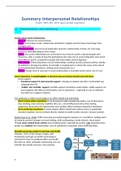Zusammenfassung
Summary Interpersonal Relationships Radboud Universiteit
- Kurs
- Hochschule
Samenvatting van de hoorcolleges van Interpersonal Relationships aan de Radboud Universiteit. Jaar . Daarnaast is de Athena-samenvatting van deze cursus hierin ook samengevat.
[ Mehr anzeigen ]



